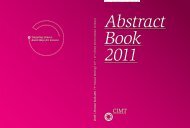Abstract Book 2010 - CIMT Annual Meeting
Abstract Book 2010 - CIMT Annual Meeting
Abstract Book 2010 - CIMT Annual Meeting
You also want an ePaper? Increase the reach of your titles
YUMPU automatically turns print PDFs into web optimized ePapers that Google loves.
L125 Huijbers | New targets & new leads<br />
Vaccination against the extra domain-B of fibronectin as a<br />
novel tumor therapy<br />
Elisabeth J. M. Huijbers 1 , Maria Ringvall 1 , Julia Femel 1 , Sebastian Kalamajski 1 , Agneta<br />
Lukinius 2 , Magnus Åbrink 1 , Lars Hellman 3 and Anna-Karin Olsson 1<br />
1 Department of Medical Biochemistry and Microbiology, Uppsala University, BMC, SE-751 23 Uppsala, Sweden<br />
2 Department of Medical Cell Biology, Uppsala University, BMC, SE-751 23 Uppsala, Sweden<br />
3 Department Cell and Molecular Biology, Uppsala University, BMC, SE-751 24 Uppsala, Sweden<br />
124<br />
During physiological angiogenesis (e.g. wound<br />
healing and proliferation of the endometrium),<br />
embryonic development and tumor angiogenesis<br />
certain extra domains of the extracellular matrix<br />
molecules fibronectin and tenascin-C are inserted<br />
into the parent molecule by alternative splicing<br />
leading to the formation of different isoforms.<br />
Splice variants of both fibronectin and tenascin-C<br />
are often co-expressed specifically around neovasculature<br />
and tumor vasculature but have low or no<br />
expression in normal adult tissue, rendering them<br />
specific targets for anti-tumor therapy.<br />
In our approach we have targeted the extra domain-<br />
B (ED-B), which is a 91 amino acid domain alternatively<br />
spliced into fibronectin and highly conserved<br />
between species. It is identical in mouse, human,<br />
rabbit, dog, monkey and several other species. To<br />
evoke an immune response against the self-antigen<br />
ED-B we used a recombinant fusion protein consisting<br />
of a bacterial thioredoxin (TRX) part fused<br />
with the extra domain B (ED-B), termed TRX-EDB.<br />
This fusion protein has been injected together<br />
with Freund’s adjuvant, a strong immunostimulator,<br />
into eight-weeks old female wild type C57bl6<br />
mice. Mice were boostered twice in a period of five<br />
weeks before they were inoculated subcutaneously<br />
with T241 fibrosarcoma cells, a tumor type known<br />
to express ED-B. After a tumor growth period of<br />
three weeks animals were sacrificed and blood and<br />
tumors were removed. Nineteen out of 20 vaccinated<br />
mice responded with production of anti-ED-B<br />
antibodies and showed a 70% reduction in tumor<br />
size compared to control animals injected with<br />
Freund’s adjuvant and vehicle, lacking anti-ED-<br />
B antibodies. Staining of murine grade III glioma<br />
tissue, to see whether the serum from TRX-EDB<br />
mice could detect native ED-B, showed an extensive<br />
vascular staining pattern compared to normal brain<br />
tissue, which is devoid of ED-B. This shows that<br />
the anti-ED-B antibodies are able to detect native<br />
tissue ED-B. Quantification of tumor necrotic area<br />
revealed a tendency towards a greater necrotic area<br />
in TRX-EDB injected compared to control animals.<br />
Further investigation of the tumors with electron<br />
microscopy revealed morphological changes of the<br />
tumor vasculature of animals with anti-ED-B antibodies,<br />
which was consistent with an immune<br />
response towards the tumor vasculature expressing<br />
ED-B. Moreover in tumors from animals with<br />
anti-ED-B antibodies an increased number of infiltrating<br />
neutrophils was observed, compared to<br />
controls, confirming an immune attack of the vasculature.<br />
Furthermore we detected an increased<br />
amount of extravasated fibrinogen, indicative of<br />
vascular leakage, in tumors of animals with anti-<br />
ED-B antibodies compared to controls.<br />
Therefore ED-B and possibly other tumor vascular<br />
antigens such as the extra domain A of fibronectin<br />
or the extra domain C of tenascin-C alone or in<br />
combination are interesting candidate targets for<br />
treatment of solid tumors. Since the choice of adjuvant<br />
is of major importance for treatment success<br />
in humans, we addressed this issue in a second<br />
study and found a non-toxic biodegradable adjuvant<br />
as potent as Freund’s in inducing an immune<br />
response against a self-antigen (see poster by Julia<br />
Femel et al.)



